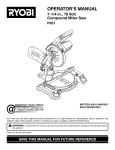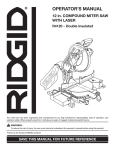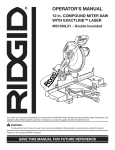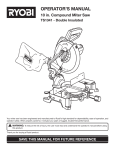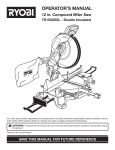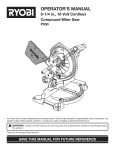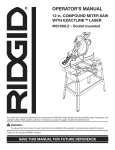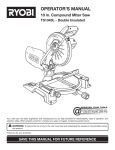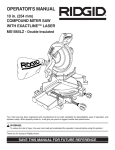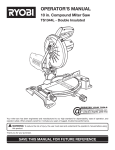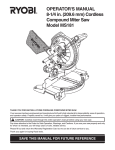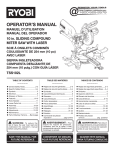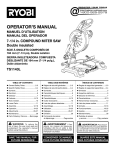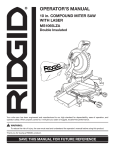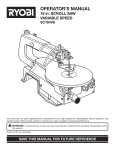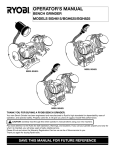Download Ryobi CS1800 Operator`s manual
Transcript
OPERATOR’S MANUAL 7-1/4 in. Compound Miter Saw TS1141 - Double Insulated Your miter saw has been engineered and manufactured to our high standard for dependability, ease of operation, and operator safety. When properly cared for, it will give you years of rugged, trouble-free performance. WARNING: To reduce the risk of injury, the user must read and understand the operator’s manual before using this product. Thank you for your purchase. SAVE THIS MANUAL FOR FUTURE REFERENCE TABLE OF CONTENTS Introduction...................................................................................................................................................................... 2 Warranty........................................................................................................................................................................... 2 General Safety Rules..................................................................................................................................................... 3-4 Specific Safety Rules..................................................................................................................................................... 4-5 Symbols............................................................................................................................................................................ 6 Electrical........................................................................................................................................................................... 7 Glossary of Terms............................................................................................................................................................. 8 Features....................................................................................................................................................................... 9-11 Tools Needed.................................................................................................................................................................. 11 Loose Parts List.............................................................................................................................................................. 12 Assembly................................................................................................................................................................... 13-21 Operation................................................................................................................................................................... 22-28 Adjustments............................................................................................................................................................... 29-30 Maintenance................................................................................................................................................................... 31 Parts Ordering / Service.................................................................................................................................... Back Page INTRODUCTION This tool has many features for making its use more pleasant and enjoyable. Safety, performance, and dependability have been given top priority in the design of this product making it easy to maintain and operate. warranty RYOBI® POWER TOOL - LIMITED TWO YEAR WARRANTY AND 30 DAY EXCHANGE POLICY One World Technologies, Inc., warrants its RYOBI® power tools with the following conditions: 30-DAY EXCHANGE POLICY: During the first 30 days after date of purchase, you may either request service under this warranty or you may exchange any RYOBI® power tool which does not work properly due to defective workmanship or materials by returning the power tool to the dealer from which it was purchased. To receive a replacement power tool or requested warranty service, you must present proof of purchase and return all original equipment packaged with the original product. The replacement power tool will be covered by the limited warranty for the balance of the two year period from the date of the original purchase. WHAT THIS WARRANTY COVERS: This warranty covers all defects in workmanship or materials in your RYOBI® power tool for a period of two years from the date of purchase. With the exception of batteries, power tool accessories are warranted for ninety (90) days. Batteries are warranted for two years. HOW TO GET SERVICE: Just return the power tool, properly packaged and postage prepaid, to an Authorized Service Center. You can obtain the location of the Service Center nearest you by contacting a service representative at One World Technologies, Inc., P.O. Box 1207, Anderson, SC 29622-1207, by calling 1-800-525-2579 or by logging on to www.ryobitools.com. When you request warranty service, you must also present proof of purchase documentation, which includes the date of purchase (for example, a bill of sale). We will repair any faulty workmanship, and either repair or replace any defective part, at our option. We will do so without any charge to you. We will complete the work in a reasonable time, but, in any case, within ninety (90) days or less. WHAT’S NOT COVERED: This warranty applies only to the original purchaser at retail and may not be transferred. This warranty only covers defects arising under normal usage and does not cover any malfunction, failure or defects resulting from misuse, abuse, neglect, alteration, modification or repairs by other than Authorized Service Centers. One World Technologies, Inc. makes no warranties, representations or promises as to the quality or performance of its power tools other than those specifically stated in this warranty. ADDITIONAL LIMITATIONS: Any implied warranties granted under state law, including warranties of merchantability or fitness for a particular purpose, are limited to two years from the date of purchase. One World Technologies, Inc. is not responsible for direct, indirect, or incidental damages, so the above limitations and exclusions may not apply to you. This warranty gives you specific legal rights, and you may also have other rights which vary from state to state. 2 GENERAL SAFETY RULES SECURE WORK. Use clamps or a vise to hold work when practical, it is safer than using your hand and frees both hands to operate the tool. WARNING: Read and understand all instructions. Failure to follow all instructions listed below, may result in electric shock, fire and/or serious personal injury. DO NOT OVERREACH. Keep proper footing and balance at all times. MAINTAIN TOOLS WITH CARE. Keep tools sharp and clean for better and safer performance. Follow instructions for lubricating and changing accessories. READ ALL INSTRUCTIONS KNOW YOUR POWER TOOL. Read the operator’s manual carefully. Learn the applications and limitations as well as the specific potential hazards related to this tool. DISCONNECT TOOLS. When not in use, before servicing, or when changing attachments, blades, bits, cutters, etc., all tools should be disconnected from power source. GUARD AGAINST ELECTRICAL SHOCK by preventing body contact with grounded surfaces. For example: pipes, radiators, ranges, refrigerator enclosures. AVOID ACCIDENTAL STARTING. Be sure switch is off when plugging in any tool. USE RECOMMENDED ACCESSORIES. Consult the operator’s manual for recommended accessories. The use of improper accessories may result in injury. KEEP GUARDS IN PLACE and in good working order. REMOVE ADJUSTING KEYS AND WRENCHES. Form habit of checking to see that keys and adjusting wrenches are removed from tool before turning it on. NEVER STAND ON TOOL. Serious injury could occur if the tool is tipped or if the cutting tool is unintentionally contacted. KEEP WORK AREA CLEAN. Cluttered areas and benches invite accidents. DO NOT leave tools or pieces of wood on the tool while it is in operation. CHECK DAMAGED PARTS. Before further use of the tool, a guard or other part that is damaged should be carefully checked to determine that it will operate properly and perform its intended function. Check for alignment of moving parts, binding of moving parts, breakage of parts, mounting and any other conditions that may affect its operation. A guard or other part that is damaged must be properly repaired or replaced by an authorized service center to avoid risk of personal injury. DO NOT USE IN DANGEROUS ENVIRONMENTS. Do not use power tools in damp or wet locations or expose to rain. Keep the work area well lit. KEEP CHILDREN AND VISITORS AWAY. All visitors should wear safety glasses and be kept a safe distance from work area. Do not let visitors contact tool or extension cord while operating. MAKE WORKSHOP CHILDPROOF with padlocks, master switches, or by removing starter keys. USE THE RIGHT DIRECTION OF FEED. Feed work into a blade or cutter against the direction of rotation of the blade or cutter only. DON’T FORCE THE TOOL. It will do the job better and safer at the feed rate for which it was designed. NEVER LEAVE TOOL RUNNING UNATTENDED. TURN THE POWER OFF. Don’t leave tool until it comes to a complete stop. USE THE RIGHT TOOL. Do not force the tool or attachment to do a job for which it was not designed. USE THE PROPER Extension Cord. Make sure your extension cord is in good condition. Use only a cord heavy enough to carry the current your product will draw. An undersized cord will cause a drop in line voltage resulting in loss of power and overheating. A wire gauge size (A.W.G.) of at least 14 is recommended for an extension cord 50 feet or less in length. If in doubt, use the next heavier gauge. The smaller the gauge number, the heavier the cord. PROTECT YOUR LUNGS. Wear a face or dust mask if the cutting operation is dusty. PROTECT YOUR HEARING. Wear hearing protection during extended periods of operation. DO NOT ABUSE CORD. Never carry tool by the cord or yank it to disconnect from receptacle. Keep cord from heat, oil, and sharp edges. USE OUTDOOR EXTENSION CORDS. When tool is used outdoors, use only extension cords with approved ground connection that are intended for use outdoors and so marked. DRESS PROPERLY. Do not wear loose clothing, neckties, or jewelry that can get caught and draw you into moving parts. Rubber gloves and nonskid footwear are recommended when working outdoors. Also wear protective hair covering to contain long hair. KEEP BLADES CLEAN, SHARP, and with sufficient set. Sharp blades minimize stalling and kickback. ALWAYS WEAR SAFETY GLASSES WITH SIDE SHIELDS. Everyday eyeglasses have only impactresistant lenses, they are not safety glasses. Blade coasts after being turned off. 3 GENERAL SAFETY RULES DO NOT USE TOOL IF SWITCH DOES NOT TURN IT ON AND OFF. Have defective switches replaced by an authorized service center. NEVER USE IN AN EXPLOSIVE ATMOSPHERE. Normal sparking of the motor could ignite fumes. Inspect TOOL CORDS periodically. If damaged, have repaired by a qualified service technician at an authorized service facility. Repair or replace a damaged or worn cord immediately. Stay constantly aware of cord location and keep it well away from the rotating blade. USE ONLY CORRECT BLADES. Do not use blades with incorrect size holes. Never use blade washers or blade bolts that are defective or incorrect. The maximum blade capacity of your saw is 7-1/4 in. Before making a cut, be sure all adjustments are secure. Inspect EXTENSION CORDS periodically and replace if damaged. POLARIZED PLUGS. To reduce the risk of electric shock, this tool has a polarized plug (one blade is wider than the other). This plug will fit in a polarized outlet only one way. If the plug does not fit fully in the outlet, reverse the plug. If it still does not fit, contact a qualified electrician to install the proper outlet. Do not change the plug in any way. BE SURE BLADE PATH IS FREE OF NAILS. Inspect for and remove all nails from lumber before cutting. Never touch blade or other moving parts during use. NEVER START A TOOL WHEN ANY ROTATiNG COMPONENT IS IN CONTACT WITH THE WORKPIECE. DO NOT operate A tool while under the influence of drugs, alcohol, or any medication. Keep TOOL dry, clean, and free from oil and grease. Always use a clean cloth when cleaning. Never use brake fluids, gasoline, petroleum-based products, or any solvents to clean tool. When servicing use only identical replacement parts. Use of any other parts may create a hazard or cause product damage. STAY ALERT AND EXERCISE CONTROL. Watch what you are doing and use common sense. Do not operate tool when you are tired. Do not rush. DOUBLE CHECK ALL SETUPS. Make sure blade is tight and not making contact with saw or workpiece before connecting to power supply. SPECIFIC SAFETY RULES Use this saw to cut wood, wood products and some plastics only. Do not cut metals, ceramics or masonry products. FIRMLY CLAMP OR BOLT the tool to a workbench or table at approximately hip height. KEEP HANDS AWAY FROM CUTTING AREA. Do not reach underneath work or in blade cutting path with hands and fingers for any reason. Always turn the power off. NEVER USE A LENGTH STOP ON THE FREE SCRAP END OF A CLAMPED WORKPIECE. NEVER hold onto or bind the free scrap end of the workpiece in any operation. If a work clamp and length stop are used together, they must both be installed on the same side of the saw table to prevent the saw from catching the loose end and kicking up. Always SUPPORT LONG WORKPIECES while cutting to minimize risk of blade pinching and kickback. Saw may slip, walk or slide while cutting long or heavy boards. Always use a clamp to secure the workpiece when possible. NEVER cut more than one piece at a time. Do not stack more than one workpiece on the saw table at a time. BE SURE THE BLADE CLEARS THE WORKPIECE. Never start the saw with the blade touching the workpiece. Allow motor to come up to full speed before starting cut. NEVER perform any operation freehand. Always place the workpiece to be cut on the miter table and position it firmly against the fence as a backstop. Always use the fence. MAKE SURE THE MITER TABLE AND SAW ARM (BEVEL FUNCTION) ARE LOCKED IN POSITION BEFORE OPERATING THE SAW. Lock the miter table by securely tightening the miter lock lever. Lock the saw arm (bevel function) by securely tightening the bevel lock knob. 4 SPECIFIC SAFETY RULES Always stay alert! Do not allow familiarity (gained from frequent use of your saw) to cause a careless mistake. ALWAYS REMEMBER that a careless fraction of a second is sufficient to inflict severe injury. Never hand hold a workpiece that is too small to be clamped. Keep hands clear of the cutting area. NEVER reach behind, under, or within three inches of the blade and its cutting path with your hands and fingers for any reason. make sure the work area has ample lighting to see the work and that no obstructions will interfere with safe operation BEFORE performing any work using your saw. NEVER reach to pick up a workpiece, a piece of scrap, or anything else that is in or near the cutting path of the blade. ALWAYS TURN OFF THE SAW before disconnecting it to avoid accidental starting when reconnecting to power supply. NEVER leave the saw unattended while connected to a power source. AVOID AWKWARD OPERATIONS AND HAND POSITIONS where a sudden slip could cause your hand to move into the blade. Always make sure you have good balance. NEVER operate your miter saw on the floor or in a crouched position. NEVER stand or have any part of your body in line with the path of the saw blade. ALWAYS release the power switch and allow the saw blade to stop rotating before raising it out of the workpiece. Do not turn the motor switch on and off rapidly. This could cause the saw blade to loosen and could create a hazard. Should this ever occur, stand clear and allow the saw blade to come to a complete stop. Disconnect your saw from the power supply and securely retighten the blade bolt. If any part of this miter saw is missing or should break, bend, or fail in any way, or should any electrical component fail to perform properly, shut off the power switch, remove the miter saw plug from the power source and have damaged, missing, or failed parts replaced before resuming operation. THIS TOOL should have the following markings: a) Wear eye protection. b) Keep hands out of path of saw blade. c) Do not operate saw without guards in place. d) Do not perform any operation freehand. e) Never reach around saw blade. f) Turn off tool and wait for saw blade to stop before raising saw arm, moving workpiece or changing settings. g) Disconnect the saw from the power source before changing blade or servicing. ALWAYS carry the tool only by the carrying handle. This saw can tip over if the saw head is released suddenly and the saw is not secured to a work surface. ALWAYS secure this saw to a stable work surface before any use to avoid serious personal injury. AVOID direct eye exposure when using the laser guide. IF THE POWER SUPPLY CORD IS DAMAGED, it must be replaced only by the manufacturer or by an authorized service center to avoid risk. SAVE THESE INSTRUCTIONS. Refer to them frequently and use to instruct other users. If you loan someone this tool, loan them these instructions also. 5 SYMBOLS The following signal words and meanings are intended to explain the levels of risk associated with this product. SYMBOL SIGNAL MEANING DANGER: Indicates an imminently hazardous situation, which, if not avoided, will result in death or serious injury. WARNING: Indicates a potentially hazardous situation, which, if not avoided, could result in death or serious injury. CAUTION: Indicates a potentially hazardous situation, which, if not avoided, may result in minor or moderate injury. CAUTION: (Without Safety Alert Symbol) Indicates a situation that may result in property damage. Some of the following symbols may be used on this tool. Please study them and learn their meaning. Proper interpretation of these symbols will allow you to operate the tool better and safer. SYMBOL NAME DESIGNATION/EXPLANATION Safety Alert Precautions that involve your safety. Read Operator’s Manual To reduce the risk of injury, user must read and understand operator’s manual before using this product. Eye Protection Always wear eye protection with side shields marked to comply with ANSI Z87.1. No Hands Symbol Failure to keep your hands away from the blade will result in serious personal injury. Wet Conditions Alert Do not expose to rain or use in damp locations. V Volts Voltage A Amperes Current Hz Hertz Frequency (cycles per second) min Minutes Time Alternating Current Type of current No Load Speed Rotational speed, at no load Class II Construction Double-insulated construction Per Minute Revolutions, strokes, surface speed, orbits etc., per minute no .../min 6 ELECTRICAL DOUBLE INSULATION EXTENSION CORDS Double insulation is a concept in safety in electric power tools, which eliminates the need for the usual three-wire grounded power cord. All exposed metal parts are isolated from the internal metal motor components with protecting insulation. Double insulated tools do not need to be grounded. When using a power tool at a considerable distance from a power source, be sure to use an extension cord that has the capacity to handle the current the product will draw. An undersized cord will cause a drop in line voltage, resulting in overheating and loss of power. Use the chart to determine the minimum wire size required in an extension cord. Only round jacketed cords listed by Underwriter’s Laboratories (UL) should be used. When working outdoors with a product, use an extension cord that is designed for outside use. This type of cord is designated with “WA” or “W” on the cord’s jacket. Before using any extension cord, inspect it for loose or exposed wires and cut or worn insulation. WARNING: The double insulated system is intended to protect the user from shock resulting from a break in the tool’s internal wiring. Observe all normal safety precautions to avoid electrical shock. NOTE: Servicing of a product with double insulation requires extreme care and knowledge of the system and should be performed only by a qualified service technician. For service, we suggest you return the tool to your nearest authorized service center for repair. Always use original factory replacement parts when servicing. **Ampere rating (on product data plate) 0-2.0 2.1-3.4 3.5-5.0 5.1-7.0 7.1-12.0 12.1-16.0 Cord LengthWire Size (A.W.G.) 25' 16 16 16 16 14 14 ELECTRICAL CONNECTION 50' 16 16 16 14 14 12 This tool has a precision-built electric motor. It should be connected to a power supply that is 120 volts, AC only (normal household current), 60 Hz. Do not operate this tool on direct current (DC). A substantial voltage drop will cause a loss of power and the motor will overheat. If the tool does not operate when plugged into an outlet, double-check the power supply. 100' 16 16 14 12 10 — **Used on 12 gauge - 20 amp circuit NOTE: AWG = American Wire Gauge WARNING: Keep the extension cord clear of the working area. Position the cord so that it will not get caught on lumber, tools, or other obstructions while you are working with a power tool. Failure to do so can result in serious personal injury. WARNING: Check extension cords before each use. If damaged replace immediately. Never use tool with a damaged cord since touching the damaged area could cause electrical shock resulting in serious injury. 7 GLOSSARY OF TERMS Push Blocks (for jointer planers) Device used to feed the workpiece over the jointer planer cutterhead during any operation. This aid helps keep the operator’s hands well away from the cutterhead. Push Blocks (for table saws) Device used to hold the workpiece during cutting operations. This aid helps keep the operator’s hands well away from the blade. Push Sticks (for table saws) Device used to push the workpiece during cutting operations. A push stick should be used for narrow ripping operations. The aid helps keep the operator’s hands well away from the blade. Resaw A cutting operation to reduce the thickness of the workpiece to make thinner pieces. Resin A sticky, sap-based substance that has hardened. Revolutions Per Minute (RPM) The number of turns completed by a spinning object in one minute. Ripping or Rip Cut A cutting operation along the length of the workpiece. Riving Knife/Spreader/Splitter (table saws) A metal piece, slightly thinner than the blade, which helps keep the kerf open and also helps to prevent kickback. Saw Blade Path The area over, under, behind, or in front of the blade. As it applies to the workpiece, that area which will be or has been cut by the blade. Set The distance that the tip of the saw blade tooth is bent (or set) outward from the face of the blade. Snipe (planers) Depression made at either end of a workpiece by cutter blades when the workpiece is not properly supported. Through Sawing Any cutting operation where the blade extends completely through the thickness of the workpiece. Throw-Back The throwing back of a workpiece usually caused by the workpiece being dropped into the blade or being placed inadvertently in contact with the blade. Workpiece or Material The item on which the operation is being done. Worktable Surface where the workpiece rests while performing a cutting, drilling, planing, or sanding operation. Anti-Kickback Pawls (radial arm and table saws) A device which, when properly installed and maintained, is designed to stop the workpiece from being kicked back toward the front of the saw during a ripping operation. Arbor The shaft on which a blade or cutting tool is mounted. Bevel Cut A cutting operation made with the blade at any angle other than 90° to the table surface. Compound Cut A cross cut made with both a miter and a bevel angle. Cross Cut A cutting or shaping operation made across the grain or the width of the workpiece. Cutterhead (planers and jointer planers) A rotating cutterhead with adjustable blades or knives. The blades or knives remove material from the workpiece. Dado Cut A non-through cut which produces a square-sided notch or trough in the workpiece (requires a special blade). Featherboard A device used to help control the workpiece by holding it securely against the table or fence during any ripping operation. FPM or SPM Feet per minute (or strokes per minute), used in reference to blade movement. Freehand Performing a cut without the workpiece being guided by a fence, miter gauge, or other aids. Gum A sticky, sap-based residue from wood products. Heel Alignment of the blade to the fence. Kerf The material removed by the blade in a through cut or the slot produced by the blade in a non-through or partial cut. Kickback A hazard that can occur when the blade binds or stalls, throwing the workpiece back toward operator. Miter Cut A cutting operation made with the workpiece at any angle to the blade other than 90°. Non-Through Cuts Any cutting operation where the blade does not extend completely through the thickness of the workpiece. Pilot Hole (drill presses) A small hole drilled in a workpiece that serves as a guide for drilling large holes accurately. 8 FEATURES PRODUCT SPECIFICATIONS Cutting Capacity with Miter at 0°/Bevel 0°: Maximum lumber sizes...................... 1-1/2 in. x 4-1/4 in. Arbor.......................................................................... 5/8 in. Cutting Capacity with Miter at 45°/Bevel 0°: Maximum lumber sizes.............................1-1/2 in. x 3 in. Blade Diameter.......................................................7-1/4 in. No Load Speed..................................... 5,800 r/min. (RPM) Cutting Capacity with Miter at 0°/Bevel 45°: Maximum lumber sizes...................... 1-1/2 in. x 3-1/2 in. Input................................... 120 V, 60 Hz, AC only, 9 Amps Cutting Capacity with Miter at 45°/Bevel 45°: Maximum lumber sizes.............................1-1/2 in. x 3 in. BLADE WRENCH Miter Lock lever “D” handle switch lock Upper Blade Guard laser guide Dust BAG Switch Trigger Lower blade guard Bevel Lock Knob “NO HANDS ZONE” BOUNDARY LINE Bevel Scale “NO HANDS ZONE” LABEL bevel scale Miter Scale miter fence throat plate MITER TABLE base WORK CLAMP Fig. 1 9 FEATURES KNOW YOUR COMPOUND MITER SAW See Figure 1. Miter Lock lever The safe use of this product requires an understanding of the information on the tool and in this operator’s manual as well as a knowledge of the project you are attempting. Before use of this product, familiarize yourself with all operating features and safety rules. Lock Pin “D” handle 9 AMP MOTOR REAR BRACKET/ Carrying Handle The saw has a powerful 9 amp motor with sufficient power to handle tough cutting jobs. It is made with all ball bearings, and has externally accessible brushes for ease of servicing. 7-1/4 in. BLADE A 7-1/4 in. blade is included with the compound miter saw. It will cut materials up to 1-1/2 in. thick or 4-1/4 in. wide, depending upon the angle at which the cut is being made. BEVEL LOCK KNOB The bevel lock knob securely locks your compound miter saw at desired bevel angles. Positive stop adjustment screws have been provided on each side of the saw arm. These adjustment screws are for making fine adjustments at 0° and 45°. Saw arm Locked in Down Position Fig. 2 BLADE WRENCH STORAGE See Figure 1. A blade wrench is packed with the saw. One end of the wrench is a phillips screwdriver and the other end is a hex key. Use the hex key end when installing or removing blade and the phillips end when removing or loosening screws. A storage area for the blade wrench is located in the saw’s base. Switch Trigger ELECTRIC BRAKE An electric brake has been provided to quickly stop blade rotation after the switch is released. Spindle Lock Button LASER GUIDE For more accurate cuts, a laser guide is included with your miter saw. When used properly, the laser guide makes accurate, precision cutting simple and easy. Fig. 3 REAR BRACKET/Carrying Handle MITER FENCE See Figure 2. For convenience when carrying or transporting the miter saw from one place to another, a carrying handle has been provided at the rear of the saw. To transport, turn off and unplug the saw, then lower the saw arm and lock it in the down position. Lock saw arm by depressing the lock pin. The miter fence on the compound miter saw has been provided to hold your workpiece securely against when making all cuts. MITER LOCK lever See Figure 2. The miter lock lever securely locks the saw at desired miter angles. SELF-RETRACTING LOWER BLADE GUARD The lower blade guard is made of shock-resistant, seethrough plastic that provides protection from each side of the blade. It retracts over the upper blade guard as the saw is lowered into the workpiece. POSITIVE STOPS ON MITER TABLE Positive stops have been provided at 0°, 15°, 22-1/2°, 31.62°, and 45°. The 15°, 22-1/2°, 31.62°, and 45° positive stops have been provided on both the left and right side of the miter table. 10 FEATURES SPINDLE LOCK BUTTON See Figure 3. The spindle lock button locks the spindle stopping the blade from rotating. Depress and hold the lock button while installing, changing, or removing blade. Switch lock SWITCH TRIGGER See Figure 4. The saw will not start until you depress the switch lock with your thumb then squeeze the switch trigger. To prevent unauthorized use of the compound miter saw, disconnect it from the power supply and lock the switch in the off position. To lock the switch, install a padlock (not included) through the hole in the switch trigger. A lock with a long shackle of 5/16 in. diameter may be used. When the lock is installed and locked, the switch is inoperable. Store the padlock key in another location. Switch trigger Padlock Fig. 4 TOOLS NEEDED The following tool (not included) is needed for making adjustments or installing the blade: Square Fig. 5 11 LOOSE PARTS LIST The following items are included with your compound miter saw: Miter Saw Base Blade Wrench Miter Saw Head AAA Batteries (2) Dust Bag Rear Bracket/Carrying Handle Work Clamp Bevel Knob Blade Bevel Indicator and Screw Operator’s Manual miter saw base DUST BAG WORK CLAMP AAA Batteries blade wrench miter saw head bevel knob rear bracket/ carrying handle blade bevel scale and screw Fig. 6 WARNING: The use of attachments or accessories not listed might be hazardous and could cause serious personal injury. 12 ASSEMBLY UNPACKING WARNING: This product requires assembly. Do not connect to power supply until assembly is complete. Failure to comply could result in accidental starting and possible serious personal injury. Carefully lift miter saw base from the carton by the “D” handle and the saw base, and place it on a level work surface. WARNING: WARNING: Do not use this product if any parts on the Loose Parts List are already assembled to your product when you unpack it. Parts on this list are not assembled to the product by the manufacturer and require customer installation. Use of a product that may have been improperly assembled could result in serious personal injury. Do not start the compound miter saw without checking for interference between the blade and the miter fence. Damage could result to the blade if it strikes the miter fence during operation of the saw. installing the rear bracket/carrying handle If factory assembled, the saw has been shipped with the saw arm secured in the down position. To release the saw arm, push down on the top of the saw arm, cut the tie-wrap, and pull out on the lock pin. Lift the saw arm by the handle. Hand pressure should remain on the saw arm to prevent sudden rise upon release of the tie wrap. Inspect the tool carefully to make sure no breakage or damage occurred during shipping. Do not discard the packing material until you have carefully inspected and satisfactorily operated the tool. The saw is factory set for accurate cutting. After assembling it, check for accuracy. If shipping has influenced the settings, refer to specific procedures explained in this manual. If any parts are damaged or missing, please call 1-800-525-2579 for assistance. See Figure 7. WARNING: A rear bracket is included with this miter saw to prevent tipping if the saw arm is released suddenly. Do not use this saw before installing the rear bracket and securely mounting the saw to a work surface or stand. Remove the screws from the rear bracket/carrying handle and set aside. Slide the bracket in the openings on the saw base, aligning the holes underneath the base with the holes in the bracket. Insert the screws into the holes and tighten securely. Warning: If any parts are damaged or missing do not operate this product until the parts are replaced. Use of this product with damaged or missing parts could result in serious personal injury. warning: Do not attempt to modify this tool or create accessories not recommended for use with this tool. Any such alteration or modification is misuse and could result in a hazardous condition leading to possible serious personal injury. screws rear bracket/ carrying handle 13 Fig. 7 ASSEMBLY Mounting Holes WARNING: See Figure 9. If not using a stand, the saw should be mounted to a firm supporting surface such as a workbench. Four bolt holes have been provided in the saw base for this purpose. Each of the four mounting holes should be bolted securely using 1/4 in. machine bolts, lock washers, and hex nuts (not included). Bolts should be of sufficient length to accommodate the saw base, lock washers, hex nuts, and the thickness of the workbench. Tighten all four bolts securely. The hole pattern for mounting to a workbench is shown in figure 9. Carefully check the workbench after mounting to make sure that no movement can occur during use. If any tipping, sliding, or walking is noted, secure the workbench to the floor before operating. Always make sure the compound miter saw is securely mounted to a workbench or an approved workstand. Failure to heed this warning can result in serious personal injury. Mounting the miter saw base to the stand See Figure 8. If a stand was included with your miter saw, follow the instructions below to mount the saw base to the stand. If a stand was not included and your saw came preassembled, or if you prefer to mount to a workbench, proceed to the next section, Mounting Holes, to mount the miter saw to a workbench. Place the miter saw base on the stand so that the base is seated firmly on the stand and the holes in the bottom of the base are aligned with the threaded shaft of the knobs in the stand. Tighten the knobs securely, but do not overtighten. saw base stand knobs Fig. 8 trace holes at these locations for hole patTern trace holes at these locations for hole patTern mounting surface BASE 14 Fig. 9 ASSEMBLY WARNING: miter saw head Assemble the saw head to the base before attempting to use the product. Using the saw head without first installing it to the base may result in serious personal injury. assembling the miter saw head to the base saw base See Figures 10 - 11. NOTE: If the miter saw you purchased is already factory assembled, proceed to the next section to install the Dust Bag. To determine if your saw was factory assembled, see UNPACKING. Secure the base to the stand or other firm supporting surface such as a workbench. Remove the paper seal from the miter saw head. Remove the tape securing the bolt from the back of the saw head. Set the bolt, spring washer, and flat washer aside. bolt Place the miter saw head on the saw base oriented vertically as shown in figure 10. Install the bolt, spring washer, and flat washer; finger tighten. Using the blade wrench provided or a standard 5 mm hex wrench, tighten the bolt. The bolt should be tightened enough so that the saw head can be set to a 30º bevel without allowing the saw head to drop under its own weight. tape paper seal flat washer Install the bevel knob with flat washer and tighten until the head is secure but not locked in position. Place the head at 0º. Install the bevel indicator so that the indicator points to 0º. Tighten the bevel indicator screw securely using the other end of the blade wrench or a standard Phillips screwdriver. flat washer bevel knob spring washer NOTE: Check the saw head’s bevel position at both 0º and 45º to make sure the indicator is correctly installed. If the saw head cannot move to the 45º position, slightly loosen the bolt at the back of the saw head. bolt bevel indicator screw Fig. 10 bevel indicator Fig. 11 15 ASSEMBLY DUST BAG See Figure 12. A dust bag is provided for use on this miter saw. It fits over the exhaust port on the upper blade guard. To install, squeeze the two metal clips to open the mouth of the bag and slide it on the exhaust port. Release the clips. The metal ring in the bag should lock in between the grooves on the exhaust port. To remove the dust bag for emptying, simply reverse the above procedure. dust bag exhaust port WORK CLAMP See Figure 13. The work clamp provides greater control by clamping the workpiece to the fence or the table. It also prevents the workpiece from creeping toward the saw blade. This is very helpful when cutting compound miters. Depending on the cutting operation and the size of the workpiece, it may be necessary to use a C-clamp instead of the work clamp to secure the workpiece prior to making the cut. Fig. 12 WARNING: In some operations, the work clamp assembly may interfere with the operation of the blade guard assembly. Always make sure there is no interference with the blade guard prior to beginning any cutting operation to reduce the risk of serious personal injury. To install the work clamp: Place the shaft of the work clamp in either hole on the saw table base. Rotate the knob on the work clamp to move it in or out as needed. INSTALLing BATTERIES IN LASER See Figure 14. Remove screw from battery compartment cover using the Phillips end of the supplied blade wrench. Remove cover and set aside. Install two AAA batteries according to polarity indicators inside the battery compartment. Work Clamp Base Fig. 13 compartment cover batteries Replace the battery compartment cover. Reinstall screw and tighten securely. screw Fig. 14 16 ASSEMBLY Danger: Laser radiation. Avoid direct eye contact with light source. WARNING: Use of controls or adjustments or performance of procedures other than those specified herein may result in hazardous radiation exposure. aligning the laser guide line See Figure 15. Unplug the saw. Draw a line on the workpiece. When the laser guide switch is turned on it will generate a red line on the work surface. This line will let you see your mark and the laser guide line at the same time, and will assist you in lining up the mark for more accurate cutting of the workpiece. Align the laser line and the mark with the blade at the uppermost position. Once both lines are in alignment, do not move the workpiece. Remove the padlock then plug the saw into the power source. Make several practice cuts on different styles and thickness of material. Repeat the steps above as necessary. Follow the directions below for using the laser guide. Removing Your Mark: Position the laser line near the left edge of your mark on the work surface in order to remove the mark. To Cut Your Mark: Position the laser line near or over your mark on the work surface in order to cut the mark. To Leave Your Mark: Position the laser line near the right edge of your mark on the work surface in order to leave the mark. After you have become familiar with using the laser guide, you will be able to remove, cut, or leave your mark on the work surface. Practice will teach you the correct position for aligning the laser line with your mark. laser line WARNING GER PRIOR TO K TRIG LOC STING LASER U ADJ ID EXPOSURE: AVO RADIATION EM ITTED R LASE A S P I E H R T T URE FROM Fig. 15 17 ASSEMBLY To Install/replace the Blade See Figures 16 - 17. WARNING: A 7-1/4 in. blade is the maximum blade capacity of the saw. Never use a blade that is too thick to allow outer blade washer to engage with the flats on the spindle. Larger blades will come in contact with the blade guards, while thicker blades will prevent the blade bolt from securing the blade on the spindle. Either of these situations could result in a serious accident and can cause serious personal injury. Unplug the saw. Raise the saw arm. Rotate lower blade guard up and remove blade bolt cover screw. Rotate blade bolt cover up and back to expose the blade bolt. Depress the spindle lock button and rotate the blade bolt until the spindle locks. Using the wrench provided, loosen and remove the blade bolt. Note: The blade bolt has left hand threads. Turn blade bolt clockwise to loosen. Remove outer blade washer. Do not remove inner blade washer. Wipe a drop of oil onto inner blade washer and outer blade washer where they contact the blade. Spindle Lock Button Fig. 16 NOTE: before use, replace SCREW and tighten SECURELY to prevent guard movement Blade BOLT cover BLADE BOLT COVER SCREW WARNING: If inner blade washer has been removed, replace it before placing blade on spindle. Failure to do so could cause an accident since blade will not tighten properly. Lower blade guard Fit saw blade inside lower blade guard and onto spindle. The blade teeth point downward at the front of saw as shown in figure 17. Replace outer blade washer. Double “D” flats on blade washers align with flats on spindle. Depress spindle lock button and replace blade bolt. Note: The blade bolt has left hand threads. Turn blade bolt counterclockwise to tighten. Blade To LOOSEN Flat(S) on Spindle Blade BOLT Caution: Always install the blade with the blade teeth and the arrow printed on the side of the blade pointing down at the front of the saw. The direction of blade rotation is also stamped with an arrow on the upper blade guard. Inner Blade Washer WITH DOUBLE “D” FLATS To Tighten Tighten blade bolt securely. Replace the lower blade guard and blade bolt cover. Replace blade bolt cover screw and tighten securely. Outer Blade Washer WITH DOUBLE “D” FLATS 18 Fig. 17 ASSEMBLY Note: Many of the illustrations in this manual show only portions of the compound miter saw. This is intentional so that we can clearly show points being made in the illustrations. Never operate the saw without all guards securely in place and in good operating condition. MITER FENCE Square SQUARING THE MITER TABLE TO THE FENCE 2 1 See Figures 18 - 21. Unplug the saw. Push down on the saw arm and pull out the lock pin to release the saw arm. Raise the saw arm. Lift the miter lock lever. Rotate the miter table until the pointer aligns with zero on the miter scale. Push the miter lock lever down to lock the miter table. Lay a square flat on the miter table. Place one leg of the square against the fence. Place the other leg of the square beside the throat plate in the miter table. The edge of the square and the throat plate in the miter table should be parallel as shown in figure 18. If the edge of the square and the throat plate in the miter table are not parallel as shown in figures 19 and 20, adjustments are needed. Using the blade wrench provided, loosen the socket head screws securing the fence. Adjust the fence left or right until the square and throat plate are parallel. Retighten the screws securely and recheck the fence-totable alignment. pointer Miter lock lever MITER TABLE 3 5 4 7 6 throat plate VIEW OF MITER TABLE SQUARE WITH FENCE Fig. 18 MITER FENCE MITER TABLE 2 1 SQUARE 3 5 4 7 6 throat plate VIEW OF MITER TABLE NOT SQUARE WITH FENCE, ADJUSTMENTS ARE REQUIRED Fig. 19 MITER FENCE MITER TABLE 1 SQUARE 2 3 4 5 6 7 throat plate VIEW OF MITER TABLE NOT SQUARE WITH FENCE, ADJUSTMENTS ARE REQUIRED Fig. 20 19 ASSEMBLY Socket Head Screw(s) Socket Head Screw(s) Miter lock lever MITER FENCE Blade MITER TABLE SQUARE VIEW OF Blade SQUARE WITH FENCE miter FENCE Fig. 22 Fig. 21 SQUARING THE BLADE TO THE FENCE MITER FENCE See Figures 21 - 24. Unplug the saw. Pull the saw arm all the way down and engage the lock pin to hold the saw arm in transport position. Lift the miter lock lever. Rotate the miter table until the pointer aligns with zero on the miter scale. Push the miter lock lever down to lock the miter table. Lay a square flat on the miter table. Place one leg of the square against the fence. Slide the other leg of the square against the flat part of saw blade. Note: Make sure that the square contacts the flat part of the saw blade, not the blade teeth. The edge of the square and the saw blade should be parallel as shown in figure 20. If the front or back edge of the saw blade angles away from the square as shown in figures 23 and 24, adjustments are needed. Using the blade wrench, loosen the socket head screws that secure the miter fence to the miter table. See figure 21. Rotate the miter fence left or right until the saw blade is parallel with the square. Retighten the screws securely and recheck the blade-tofence alignment. Blade MITER TABLE SQUARE VIEW OF Blade NOT SQUARE WITh FENCE, ADJUSTMENTS ARE REQUIRED Fig. 23 MITER FENCE Blade The saw has two scale indicators, one on the bevel scale and one on the miter scale. After squaring adjustments have been made, it may be necessary to loosen the indicator screws and reset them to zero. MITER TABLE SQUARE VIEW OF Blade NOT SQUARE WITH FENCE, ADJUSTMENTS ARE REQUIRED Fig. 24 20 ASSEMBLY SQUARING THE BLADE TO THE MITER TABLE BEVEL LOCK KNOB See Figures 25 - 28. Unplug the saw. Pull the saw arm all the way down and engage the lock pin to hold the saw arm in transport position. MITER FENCE Lift the miter lock lever. Rotate the miter table until the pointer aligns with zero on the miter scale. Push the miter lock lever down to lock the miter table. Loosen bevel lock knob and set saw arm at 0° bevel (blade set 90° to miter table). Tighten bevel lock knob. Place a square against the miter table and the flat part of saw blade. square Note: Make sure that the square contacts the flat part of the saw blade, not the blade teeth. MITER TABLE blade CORRECT VIEW OF Blade SQUARE WITH Miter Table Fig. 26 Rotate the blade by hand and check the blade-to-table alignment at several points. BEVEL LOCK KNOB The edge of the square and the saw blade should be parallel as shown in figure 26. If the top or bottom of the saw blade angles away from the square as shown in figures 27 and 28, adjustments are needed. MITER FENCE Loosen the bevel lock knob. Adjust positive stop adjustment screw to bring saw blade into alignment with the square. See Positive Stop Adjustment in the Adjustments section. blade Retighten bevel lock knob. Recheck blade-to-table alignment. square Note: The above procedure can be used to check blade squareness of the saw blade to the miter table at both 0° and 45° angles. MITER TABLE VIEW OF Blade NOT SQUARe WITH Miter Table, ADJUSTMENTS ARE REQUIRED Fig. 27 The saw has two scale indicators, one on the bevel scale and one on the miter scale. After squaring adjustments have been made, it may be necessary to loosen the indicator screws and reset them to zero. BEVEL LOCK KNOB MITER FENCE scale indicator blade Miter SCALE BEVEL SCALE INDICATOR SCREW square MITER TABLE VIEW OF Blade NOT SQUARE WITH Miter Table, ADJUSTMENTS ARE REQUIRED Fig. 28 Fig. 25 21 OPERATION CUTTING WITH YOUR Compound MITER SAW WARNING: Do not allow familiarity with tools to make you careless. Remember that a careless fraction of a second is sufficient to inflict serious injury. WARNING: When using a work clamp or C-clamp to secure your workpiece, clamp workpiece on one side of the blade only. The workpiece must remain free on one side of the blade to prevent the blade from binding in workpiece. The workpiece binding the blade will cause motor stalling and kickback. This situation could cause an accident resulting in possible serious personal injury. WARNING: Always wear eye protection with side shields marked to comply with ANSI Z87.1. Failure to do so could result in objects being thrown into your eyes, resulting in possible serious injury. WARNING: WARNING: EVER move the workpiece or make adjustment to any N cutting angle while the saw is running and the blade is rotating. Any slip can result in contact with the blade causing serious personal injury. Do not use any attachments or accessories not recommended by the manufacturer of this tool. The use of attachments or accessories not recommended can result in serious personal injury. APPLICATIONS To Cross cut This product has been designed only for the purposes listed below: See Figures 29 - 30. A cross cut is made by cutting across the grain of the workpiece. A straight cross cut is made with the miter table set at the 0° position. Miter cross cuts are made with the miter table set at some angle other than zero. Pull out the lock pin and lift saw arm to its full height. Lift the miter lock lever. Rotate the miter table until the pointer aligns with zero on the miter scale. Cross cutting wood and plastic (do not cut metals, ceramics, or masonry products.) Cross cutting miters, joints, etc. for picture frames moldings, door casings, and fine joinery Bevel cutting and compound cutting Note: The blade provided is fine for most wood cutting operations, but for fine joinery cuts or cutting plastic, use one of the accessory blades available from the dealer. CROSS CUT WARNING: Before starting any cutting operation, clamp or bolt the compound miter saw to a workbench or an approved workstand. Never operate the miter saw on the floor or in a crouched position. Failure to heed this warning can result in serious personal injury. WARNING: To avoid serious personal injury, always lock the miter lock lever before making a cut. Failure to do so could result in movement of the control arm or miter table while making a cut. WARNING: To avoid serious personal injury, keep hands outside the no hands zone, at least 3 in. from the blade. Never perform any cutting operation freehand (without holding workpiece against the fence). The blade could grab the workpiece if it slips or twists. work clamp 22 Fig. 29 OPERATION Note: You can quickly locate 0°, 15°, 22-1/2°, left or right, 31.62° and 45° left or right as you rotate the control arm. The miter table will seat itself in one of the positive stop index points, located in base. miter CUT Push the miter lock lever down to lock the miter table. Place the workpiece flat on the miter table with one edge securely against the fence. If the board is warped, place the convex side against the fence. If the concave edge of a board is placed against the fence, the board could collapse on the blade at the end of the cut, jamming the blade. When cutting long pieces of lumber or molding, support the opposite end of the stock with a roller stand or with a work surface level with the saw table. See Figure 35. Align cutting line on workpiece with edge of saw blade. Grasp the stock firmly with one hand and secure it against the fence. Use the optional work clamp or a C-clamp to secure the workpiece when possible. WORK CLAMP Before turning on the saw, perform a dry run of the cutting operation just to make sure that no problems will occur when the cut is made. Fig. 30 BEVEL SCALE INDICATOR POINT Grasp the saw handle firmly. Depress the switch lock with thumb then squeeze the switch trigger. Allow several seconds for the blade to reach maximum speed. Slowly lower the blade into and through the workpiece. Release the switch trigger and allow the blade to stop rotating before raising the blade out of the workpiece. Wait until the electric brake stops blade from turning before removing the workpiece from the miter table. TO Bevel Cut See Figures 31 - 32. INDICATOR SCREW scale indicator A bevel cut is made by cutting across the grain of the workpiece with the blade angled to the workpiece. A straight bevel cut is made with the miter table set at the zero degree position and the blade set at an angle between 0° and 45°. Fig. 31 Bevel Cut Pull out the lock pin and lift saw arm to its full height. Lift the miter lock lever. Rotate the miter table until the pointer aligns with zero on the miter scale. NOTE: You can quickly locate 0° as you rotate the control arm. The miter table will seat itself in one of the positive stop index points, located in base. bevel lock knob Push the miter lock lever down to lock the miter table. Loosen the bevel lock knob and move the saw arm to the left to the desired bevel angle. Bevel angles can be set from 0° to 45°. Align the indicator point for the desired angle. Once the saw arm has been set at the desired angle, securely tighten the bevel lock knob. WORK CLAMP Fig. 32 23 OPERATION Place the workpiece flat on the miter table with one edge securely against the fence. If the board is warped, place the convex side against the fence. If the concave edge of a board is placed against the fence, the board could collapse on the blade at the end of the cut, jamming the blade. Compound Miter Cut When cutting long pieces of lumber or molding, support the opposite end of the stock with a roller stand or with a work surface level with the saw table. See Figure 35. Align the cutting line on the workpiece with the edge of saw blade. Grasp the stock firmly with one hand and secure it against the fence. Use the optional work clamp or a C-clamp to secure the workpiece when possible. See Figure 32. Before turning on the saw, perform a dry run of the cutting operation just to make sure that no problems will occur when the cut is made. Grasp the saw handle firmly. Depress the switch lock with thumb then squeeze the switch trigger. Allow several seconds for the blade to reach maximum speed. Work CLAMP Slowly lower the blade into and through the workpiece. Fig. 33 Release the switch trigger and allow the saw blade to stop rotating before raising the blade out of the workpiece. Wait until the electric brake stops blade from turning before removing the workpiece from miter table. Pull out the lock pin and lift saw arm to its full height. Lift the miter lock lever. Rotate the miter table until the pointer aligns with zero on the miter scale. to Compound Miter Cut See Figures 33 - 34. A compound miter cut is a cut made using a miter angle and a bevel angle at the same time. This type of cut is used to make picture frames, cut molding, make boxes with sloping sides, and for certain roof framing cuts. NOTE: You can quickly locate 0°, 15°, 22-1/2°, left or right, 31.62° and 45° left or right as you rotate the control arm. The miter table will seat itself in one of the positive stop index points, located in base. Push the miter lock lever down to lock the miter table. To make this type of cut the control arm on the miter table must be rotated to the correct angle and the saw arm must be tilted to the correct bevel angle. Care should always be taken when making compound miter setups due to the interaction of the two angle settings. Loosen the bevel lock knob and move the saw arm to the left to the desired bevel angle. Bevel angles can be set from 0° to 45°. Once the saw arm has been set at the desired angle, securely tighten the bevel lock knob. Adjustments of miter and bevel settings are interdependent with one another. Each time you adjust the miter setting you change the effect of the bevel setting. Also, each time you adjust the bevel setting you change the effect of the miter setting. Recheck miter angle setting. Make a test cut in scrap material. It may take several settings to obtain the desired cut. The first angle setting should be checked after setting the second angle, since adjusting the second angle affects the first. Once the two correct settings for a particular cut have been obtained, always make a test cut in scrap material before making a finish cut in good material. 24 OPERATION Place the workpiece flat on the miter table with one edge securely against the fence. If the board is warped, place the convex side against the fence. If the concave edge of a board is placed against the fence, the board could collapse on the blade at the end of the cut, jamming the blade. When cutting long pieces of lumber or molding, support the opposite end of the stock with a roller stand or with a work surface level with the saw table. See Figure 35. Align the cutting line on the workpiece with the edge of saw blade. Grasp the stock firmly with one hand and secure it against the fence. Use the optional work clamp or a C-clamp to secure the workpiece when possible. See Figure 34. Before turning on the saw, perform a dry run of the cutting operation just to make sure that no problems will occur when the cut is made. Grasp the saw handle firmly. Depress the switch lock with thumb then squeeze the switch trigger. Allow several seconds for the blade to reach maximum speed. Slowly lower the blade into and through the workpiece. Release the switch trigger and allow the saw blade to stop rotating before raising the blade out of the workpiece. Wait until the electric brake stops blade from turning before removing the workpiece from miter table. 45° x 45° COMPOUND MITER CUT Fig. 34 to SUPPORT LONG WORKPIECES See Figure 35. Long workpieces need extra supports. Supports should be placed along the workpiece so it does not sag. The support should let the workpiece lay flat on the base of the saw and worktable during the cutting operation. Use the optional work clamp or a C-clamp to secure the workpiece. Long workpiece 0 Workpiece supports 25 Fig. 35 OPERATION CUTTING COMPOUND MITERS To aid in making the correct settings, the compound angle setting chart below has been provided. Since compound cuts are the most difficult to accurately obtain, trial cuts should be made in scrap material, and much thought and planning made, prior to making the required cut. PITCH OF SIDE 0° 5° 10° 15° 20° 25° 30° 35° 40° 45° 50° NUMBER OF SIDES 6 7 8 M- 45.00° M- 36.00° B- 0.00° B- 0.00° M- 30.00° B- 0.00° M- 25.71° B- 0.00° M- 44.89° B- 3.53° M- 44.56° B- 7.05° M- 44.01° B- 10.55° M- 35.90° B- 2.94° M- 35.58° B- 5.86° M- 35.06° B- 8.75° M34.32° M- 43.22° B11.60° B- 14.00° M- 42.19° M- 33.36° B- 17.39° B- 14.38° M- 29.91° B- 2.50° M- 29.62° B- 4.98° M- 29.15° B- 7.44° M- 28.48° B- 9.85° M- 27.62° B- 12.20° M- 25.63° B- 2.17° M- 25.37° B- 4.32° M- 24.95° B- 6.45° M- 24.35° B- 8.53° M- 23.56° B- 10.57° M- 22.50° B- 0.00° M- 22.42° B- 1.91° M- 22.19° B- 3.81° M- 21.81° B- 5.68° M- 21.27° B- 7.52° M- 20.58° B- 9.31° M- 40.89° B- 20.70° M- 39.32° B- 23.93° M- 26.57° B- 14.48° M- 25.31° B- 16.67° M- 22.64° B- 12.53° M- 19.73° B- 11.03° M- 23.86° B- 18.75° M- 22.21° B- 20.70° M- 21.53° B- 14.41° M- 20.25° B- 16.19° M- 18.74° B- 12.68° M- 17.60° B- 14.24° M- 18.80° B- 17.87° M- 16.32° B- 15.70° M- 20.36° B- 22.52° M- 17.20° B- 19.41° M- 14.91° M- 13.17° B- 17.05° B- 15.19° 4 5 M- 32.18° B- 17.09° M- 30.76° B- 19.70° M- 37.45° M- 29.10° B- 27.03° B- 22.20° M- 35.26° M- 27.19° B- 30.00° B- 24.56° M- 32.73° M- 25.03° B- 32.80° B- 26.76° 9 10 M- 20.00° M- 18.00° B- 0.00° B- 0.00° M- 19.93° M- 17.94° B- 1.71° B- 1.54° M- 19.72° M- 17.74° B- 3.40° B- 3.08° M- 19.37° M- 17.42° B- 5.08° B- 4.59° M- 18.88° M- 16.98° B- 6.72° B- 6.07° M- 18.26° M- 16.41° B- 8.31° B- 7.50° M- 17.50° M- 15.72° B- 9.85° B- 8.89° M- 16.60° M- 14.90° B- 11.31° B- 10.21° M- 15.58° M- 13.98° B- 12.70° B- 11.46° M- 14.43° M- 12.94° B- 14.00° B- 12.62° M- 11.80° B- 13.69° 55° M- 29.84° M- 22.62° B- 35.40° B- 28.78° M- 18.32° B- 24.18° M- 15.44° B- 20.82° M- 13.36° M- 11.79° M- 10.56° B- 18.27° B- 16.27° B- 14.66° 60° M- 26.57° M- 19.96° B- 37.76° B- 30.60° M- 13.54° B- 22.07° M- 11.70° M- 10.31° B- 19.35° B- 17.23° 65° M- 22.91° M- 17.07° B- 39.86° B- 32.19° M- 16.10° B- 25.66° M- 13.71° B- 26.95° M- 11.50° B- 23.16° M- 9.23° B- 15.52° M7.82° M- 9.93° M- 8.74° B -16.26° B- 20.29° B- 18.06° 70° M- 18.88° M- 13.95° B- 41.64° B- 33.53° M- 11.17° B- 28.02° M- 9.35° B- 24.06° M- 8.06° M- 7.10° B- 21.08° B- 18.75° M- 6.34° B- 16.88° M- 14.51° B- 43.08° M- 9.85° B- 44.14° M- 4.98° B- 44.78° M- 10.65° B- 34.59° M- 7.19° B- 35.37° M- 3.62° B- 35.84° M- 8.50° B- 28.88° M- 5.73° B- 29.50° M- 2.88° B- 29.87° M- 7.10° B- 24.78° M- 4.78° B- 25.30° M- 2.40° B- 25.61° M- 6.12° B- 21.69° M- 4.11° B- 22.14° M- 2.07° B- 22.41° M- 5.38° B- 19.29° M- 3.62° B- 19.68° M- 1.82° B- 19.92° M- 4.81° B- 17.37° M- 3.23° B- 17.72° M- 1.62° B- 17.93° M- 0.00° M- 0.00° B- 45.00° B- 36.00° M- 0.00° B- 30.00° M- 0.00° B- 25.71° M- 0.00° M- 0.00° B- 22.50° B- 20.00° M- 0.00° B- 18.00° 75° 80° 85° 90° Each B (Bevel) and M (Miter) Setting is Given to the Closest 0.005°. COMPOUND-ANGLE SETTINGS FOR POPULAR STRUCTURES 26 OPERATION cutting crown molding When setting the bevel and miter angles for compound miters, remember that the settings are interdependent; changing one angle changes the other angle as well. Keep in mind that the angles for crown molding are very precise and difficult to set. Since it is very easy for these angles to shift, all settings should first be tested on scrap molding. Also most walls do not have angles of exactly 90°, therefore, you will need to fine tune your settings. When cutting crown molding by this method the bevel angle should be set at 33.85°. The miter angle should be set at 31.62° either right or left, depending on the desired cut for the application. See the chart for correct angle settings and correct positioning of crown molding on miter table. The settings in the chart can be used for cutting. All Standard (U.S.) crown molding with 52° and 38° angles. The crown molding is placed flat on the miter table using the compound features of the miter saw. This compound miter saw does an excellent job of cutting crown molding. In general, compound miter saws do a better job of cutting crown molding than any other tool made. In order to fit properly, crown molding must be compound mitered with extreme accuracy. The two contact surfaces on a piece of crown molding that fit flat against the ceiling and the wall of a room are at angles that, when added together, equal exactly 90°. Most crown molding has a top rear angle (the section that fits flat against the ceiling) of 52° and a bottom rear angle (the section that fits flat against the wall) of 38°. Laying molding flat on the miter table See Figure 36. To use this method for accurately cutting crown molding for a 90° inside or outside corner, lay the molding with its broad back surface flat on the miter table and against the fence. 52° ceiling 38° w a l l inside corner Fence Fence Top edge against fence = LEFT SIDE, INSIDE CORNER RIGHT SIDE, OUTSIDE CORNER outside corner BOTTOM edge against fence = RIGHT SIDE, INSIDE CORNER LEFT SIDE, OUTSIDE CORNER MITER Table MITER Table crown molding flat on miter table 27 Fig. 36 OPERATION Bevel Angle Setting Type of Cut 33.85° Left side, inside corner 1. Top edge of molding against fence 2. Miter table set right 31.62° 3. Save left end of cut 33.85° Right side, inside corner 1. Bottom edge of molding against fence 2. Miter table set left 31.62° 3. Save left end of cut 33.85° Left side, outside corner 1. Bottom edge of molding against fence 2. Miter table set left 31.62° 3. Save right end of cut 33.85° Right side, outside corner 1. Top edge of molding against fence 2. Miter table set right 31.62° 3. Save right end of cut Right Fig. 37 cutting warped material See Figures 37 - 38. When cutting warped material, always make sure it is positioned on the miter table with the convex side against the fence as shown in figure 37. If the warped material is positioned the wrong way as shown in figure 38, it will pinch the blade near the completion of the cut. WARNING: To avoid a kickback and to avoid serious personal injury, never position the concave edge of bowed or warped material against the fence. WRONG 28 Fig. 38 ADJUSTMENTS POSITIVE STOP ADJUSTMENTS WARNING: See Figure 39. Note: These adjustments were made at the factory and normally do not require readjustment. To adjust: Unplug the saw. Loosen the bevel lock knob by turning the knob counterclockwise. Square the blade to the miter table as described in the Assembly section of this manual. If the blade is out of square, adjust by tightening or loosening the positive stop adjustment screw. Retighten bevel lock knob. Recheck blade-to-table alignment. Note: The above procedure can be used to check blade squareness of the saw blade to the miter table at both 0° and 45° angles. The saw has two scale indicators, one on the bevel scale and one on the miter scale. After squaring adjustments have been made, it may be necessary to loosen the indicator screws and reset them to zero. Before performing any adjustment, make sure the tool is unplugged from the power supply. Failure to heed this warning could result in serious personal injury. The compound miter saw has been adjusted at the factory for making very accurate cuts. However, some of the components might have been jarred out of alignment during shipping. Also, over a period of time, readjustment will probably become necessary due to wear. After unpacking the saw, check the following adjustments before you begin using the saw. Make any readjustments that are necessary and periodically check the parts alignment to make sure that the saw is cutting accurately. CAUTION: Do not start the compound miter saw without checking for interference between the blade and the throat plate. Damage could result to the blade if it strikes the throat plate during operation of the saw. PIVOT ADJUSTMENTS Note: These adjustments were made at the factory and normally do not require readjustment. BEVEL LOCK KNOB TRAVEL PIVOT ADJUSTMENT The saw arm should rise completely to the up position by itself. If the saw arm does not raise by itself or if there is play in the pivot joints, have saw repaired by at your nearest authorized service center. Bevel Pivot Adjustment The compound miter saw should bevel easily by loosening the bevel lock knob and tilting the saw arm to the left. If movement is tight or if there is play in the pivot, have saw repaired by at your nearest authorized service center. Positive Stop Adjustment Screw FOR 0° ANGLES Positive Stop Adjustment Screw FOR 45° ANGLES Fig. 39 29 ADJUSTMENTS laser adjustment screw Danger: Laser radiation. Avoid direct eye contact with light source. WARNING: Use of controls or adjustments or performance of procedures other than those specified herein may result in hazardous radiation exposure. TO ADJUST THE LASER GUIDE See Figure 40. Use the work clamp or a C-clamp to secure a piece of scrap wood. Plug the saw into the power source and make a slight cut to score the wood. Fig. 40 Release the switch trigger and allow the saw blade to stop rotating before raising the blade. Raise the saw arm. Unplug the saw. To adjust the laser, loosen the laser adjustment screw using the Phillips end of the supplied blade wrench. NOTE: When properly aligned, the laser should be on the left edge of the kerf. Once aligned, tighten the screw then remove the blade wrench. unlock To adjust the miter lock lever See Figure 41. Prior to squaring the saw blade to the fence, check and adjust the miter lock lever, if needed. In the “locked” position, the action of pushing the miter lock lever fully down should feel tight and secure. Considerable effort should be required to move the miter table. If the table moves easily when in the “locked” position, an adjustment of the miter lock lever is required. To adjust: Unplug the saw. lock miter lock lever Fig. 41 Push the miter lock lever fully down to lock. Pull the miter lock lever out to the right to disengage, then pull forward to adjust. Release miter lock lever to re-engage Recheck the miter table to ensure proper tightness. 30 MAINTENANCE WARNING: Brush Cap When servicing, use only identical replacement parts. Use of any other parts may create a hazard or cause product damage. Brush Assembly WARNING: Always wear eye protection with side shields marked to comply with ANSI Z87.1 during product operation. If operation is dusty, also wear a dust mask. Brush Assembly Brush Cap GENERAL MAINTENANCE Avoid using solvents when cleaning plastic parts. Most plastics are susceptible to damage from various types of commercial solvents and may be damaged by their use. Use clean cloths to remove dirt, dust, oil, grease, etc. Fig. 42 WARNING: Brush REPLACEMENT Do not at any time let brake fluids, gasoline, petroleumbased products, penetrating oils, etc., come in contact with plastic parts. Chemicals can damage, weaken or destroy plastic which may result in serious personal injury. See Figure 42. The saw has externally accessible brush assemblies that should be periodically checked for wear. Proceed as follows when replacement is required: Unplug the saw. Electric tools used on fiberglass material, wallboard, spackling compounds, or plaster are subject to accelerated wear and possible premature failure because the fiberglass chips and grindings are highly abrasive to bearings, brushes, commutators, etc. Consequently, we do not recommend using this tool for extended work on these types of materials. However, if you do work with any of these materials, it is extremely important to clean the tool using compressed air. WARNING: Failure to unplug the saw could result in accidental starting causing serious injury. Remove brush cap with a screwdriver. Brush assembly is spring loaded and will pop out when you remove brush cap. Remove brush assembly. Check for wear. Replace both brushes when either has less than 1/4 in. length of carbon remaining. Do not replace one side without replacing the other. Reassemble using new brush assemblies. Make sure curvature of brush matches curvature of motor and that brush moves freely in brush tube. Make sure brush cap is oriented correctly (straight) and replace. Tighten brush cap securely. Do not overtighten. LUBRICATION All of the bearings in this tool are lubricated with a sufficient amount of high grade lubricant for the life of the unit under normal operating conditions. Therefore, no further lubrication is required. 31 OPERATOR’S MANUAL 7-1/4 in. Compound Miter Saw TS1141 - Double Insulated WARNING: Some dust created by power sanding, sawing, grinding, drilling, and other construction activities contains chemicals known to cause cancer, birth defects or other reproductive harm. Some examples of these chemicals are: •lead from lead-based paints, •crystalline silica from bricks and cement and other masonry products, and •arsenic and chromium from chemically-treated lumber. Your risk from these exposures varies, depending on how often you do this type of work. To reduce your exposure to these chemicals: work in a well ventilated area, and work with approved safety equipment, such as those dust masks that are specially designed to filter out microscopic particles. • SERVICE Now that you have purchased your tool, should a need ever exist for repair parts or service, simply contact your nearest Authorized Service Center. Be sure to provide all pertinent facts when you call or visit. Please call 1-800-525-2579 for your nearest Authorized Service Center. You can also check our web site at www.ryobitools.com for a complete list of Authorized Service Centers. • MODEL NO. AND SERIAL NO. The model number of this tool will be found on a plate attached to the motor housing. Please record the model number and serial number in the space provided below. • HOW TO ORDER REPAIR PARTS When ordering repair parts, always give the following information: • MODEL NUMBER • SERIAL NUMBER TS1141 Ryobi® is a registered trademark of Ryobi Limited used under license. ONE WORLD TECHNOLOGIES, INC. 1428 Pearman Dairy Road, Anderson, SC 29625 Phone 1-800-525-2579 www.ryobitools.com 987000-952 1-14-10 (REV:01)
































